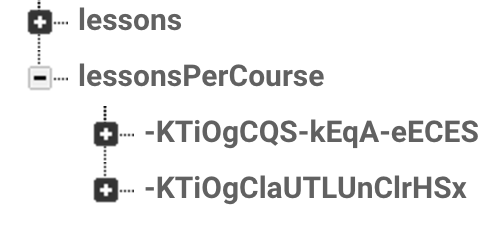At some point, you might need to udpate multi collections and those collections should all updated successfully, otherwise we don't update anything. You can use 'FirebaseRef' to get the root node (the parent all for the collections).
constructor(private rt: RealtimeService, @Inject(FirebaseRef) fb) { this.rootDb = fb.database().ref(); // To get the root firebase ref }
You can inject 'FirebaseRef' by using @Inject.
For example we want to update 'lessons' and 'lessonsPreCourse' at the same time, make sure if both sucess, both get udpated, one has error then abort the transaction:

To add value into lessonsPerCourse key, we need to grap the new Lesson key first.

To do that, we can generate a new lesson key by doing:
const newLessonKey = this.rootDb.child('lessons').push().key;
This won't actually insert a row into the 'lessons' table, it just create a new key for lessons collection for us to use locally.
Once we got the new lesson key, then we can update the table by calling 'update()' on 'this.rootDb':
this.rootDb.update(dataToSave) .then( (val) => { }, (err) => { });
The full code for create new lesson:
createNewLesson(courseId: string, lesson: Lesson): Observable<any>{ const lessonToSave = Object.assign({}, lesson, {courseId}); // Generate a new key under 'lessons' collection, db won't change currently const newLessonKey = this.rootDb.child('lessons').push().key; const dataToSave = {}; dataToSave[`lessons/${newLessonKey}`] = lessonToSave; dataToSave[`lessonsPerCourse/${courseId}/${newLessonKey}`] = true; const subject = new Subject(); this.rootDb.update(dataToSave) .then( (val) => { subject.next(val); subject.complete(); }, (err) => { subject.error(err); subject.complete(); }); return subject.asObservable(); }
Notice that, we also use Subject(), because the function expect to return an Observable. So we call:
return subject.asObservable();
Also we call complete() method everytime, this is important to complete a subject.
subject.complete();
To mention that, subject is not the only way to can convert Promise to Observable, we can also do:
return Observable.fromPromise(this.rootDb.update(dataToSave));